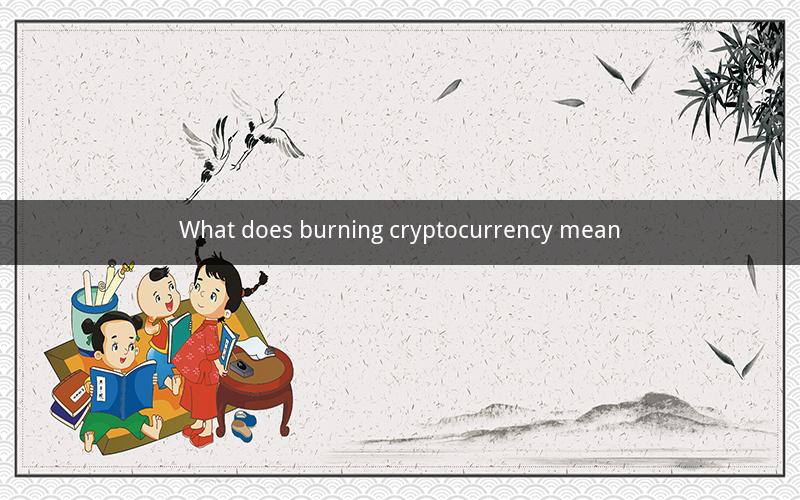
Table of Contents
1. Introduction to Cryptocurrency
2. Understanding Cryptocurrency Transactions
3. The Concept of Burning Cryptocurrency
4. Reasons for Burning Cryptocurrency
5. The Process of Burning Cryptocurrency
6. The Impact of Burning Cryptocurrency
7. Legal and Ethical Considerations
8. Case Studies of Cryptocurrency Burning
9. The Future of Cryptocurrency Burning
10. Conclusion
1. Introduction to Cryptocurrency
Cryptocurrency has revolutionized the financial world, offering a decentralized and secure method of transaction. It operates on blockchain technology, ensuring transparency and eliminating the need for intermediaries. Bitcoin, the first and most well-known cryptocurrency, paved the way for numerous other digital currencies to emerge.
2. Understanding Cryptocurrency Transactions
Cryptocurrency transactions involve the transfer of digital assets from one party to another. These transactions are recorded on a public ledger, known as the blockchain, which is maintained by a network of computers. Once a transaction is confirmed, it becomes immutable and cannot be altered.
3. The Concept of Burning Cryptocurrency
Burning cryptocurrency refers to the process of permanently removing a certain amount of cryptocurrency from circulation. This is achieved by destroying the private keys associated with the cryptocurrency, rendering it unusable. The concept of burning cryptocurrency has gained popularity among various cryptocurrency communities.
4. Reasons for Burning Cryptocurrency
Several reasons motivate individuals and organizations to burn cryptocurrency:
- Reducing Supply: By burning cryptocurrency, the total supply of the currency is reduced, which can increase its value.
- Scarcity: Burning cryptocurrency creates a sense of scarcity, as the available supply becomes limited.
- Community Engagement: Burning cryptocurrency can be used as a way to engage with the community and demonstrate commitment to the project.
- Control: Burning cryptocurrency can help prevent inflation and maintain control over the currency's supply.
5. The Process of Burning Cryptocurrency
The process of burning cryptocurrency involves the following steps:
- Identify the Cryptocurrency: Determine the specific cryptocurrency that will be burned.
- Acquire the Cryptocurrency: Obtain the necessary amount of cryptocurrency to be burned.
- Destroy Private Keys: Use a secure method to destroy the private keys associated with the cryptocurrency.
- Announce the Burning: Inform the community about the burning event and its purpose.
- Verify the Burning: Ensure that the private keys have been destroyed and the cryptocurrency is no longer in circulation.
6. The Impact of Burning Cryptocurrency
Burning cryptocurrency can have several positive and negative impacts:
- Positive Impacts:
- Increased value: Reduced supply can lead to an increase in the value of the cryptocurrency.
- Enhanced scarcity: Scarcity can make the cryptocurrency more attractive to investors.
- Community engagement: Burning cryptocurrency can foster a sense of community and commitment.
- Negative Impacts:
- Reduced liquidity: Burning cryptocurrency can reduce its liquidity, making it more difficult to trade.
- Regulatory concerns: Burning cryptocurrency may raise regulatory concerns, depending on the jurisdiction.
7. Legal and Ethical Considerations
Burning cryptocurrency raises legal and ethical considerations, including:
- Legal: Burning cryptocurrency may be subject to regulations, depending on the jurisdiction. It is essential to ensure compliance with applicable laws.
- Ethical: Burning cryptocurrency should be done with transparency and a clear purpose, to maintain trust within the community.
8. Case Studies of Cryptocurrency Burning
Several cryptocurrencies have implemented burning as part of their strategy:
- Bitcoin Cash (BCH): Bitcoin Cash has a fixed supply of 21 million coins, and the burning process is used to maintain this supply.
- Litecoin (LTC): Litecoin has a burning mechanism that rewards users for mining new blocks.
- EOS (EOS): EOS has a system that automatically burns tokens when they are transferred between accounts.
9. The Future of Cryptocurrency Burning
The future of cryptocurrency burning remains uncertain. While it has shown potential in certain cases, it also poses risks and challenges. As the cryptocurrency market continues to evolve, the role of burning may change, and new methods may emerge.
10. Conclusion
Burning cryptocurrency is a unique and innovative approach to managing the supply and value of digital currencies. While it has its advantages and disadvantages, it is essential to consider the legal and ethical implications before implementing such a strategy. As the cryptocurrency market continues to grow, the future of burning may provide new insights and opportunities for both investors and developers.
Questions and Answers
1. Q: What is the primary purpose of burning cryptocurrency?
A: The primary purpose of burning cryptocurrency is to reduce the supply, increase value, and create a sense of scarcity.
2. Q: How does burning cryptocurrency affect its value?
A: Burning cryptocurrency can increase its value by reducing the supply and creating a sense of scarcity.
3. Q: Can burning cryptocurrency be reversed?
A: No, burning cryptocurrency is irreversible, as it involves destroying the private keys associated with the currency.
4. Q: Are there any legal risks associated with burning cryptocurrency?
A: Yes, burning cryptocurrency may raise legal risks, depending on the jurisdiction and the specific circumstances.
5. Q: Can burning cryptocurrency be used to manipulate the market?
A: Yes, burning cryptocurrency can be used to manipulate the market, as it can create a false sense of scarcity.
6. Q: How does burning cryptocurrency affect the liquidity of the currency?
A: Burning cryptocurrency can reduce the liquidity of the currency, as the available supply becomes limited.
7. Q: Can burning cryptocurrency be considered a form of inflation control?
A: Yes, burning cryptocurrency can be considered a form of inflation control, as it reduces the total supply of the currency.
8. Q: How does burning cryptocurrency affect the community?
A: Burning cryptocurrency can foster a sense of community and commitment among the cryptocurrency holders.
9. Q: Can burning cryptocurrency be used to reward miners?
A: Yes, some cryptocurrencies use a burning mechanism to reward miners for their efforts.
10. Q: Is burning cryptocurrency a sustainable strategy for long-term growth?
A: The sustainability of burning cryptocurrency as a strategy for long-term growth remains uncertain and depends on various factors.